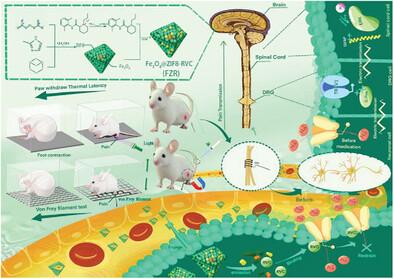A Dual-Responsive Fe₃O₄@ZIF-8 Nanoplatform Combining Magnetic Targeting and pH Sensitivity for Low Back Pain Therapy
IF 13
2区 材料科学
Q1 CHEMISTRY, MULTIDISCIPLINARY
引用次数: 0
Abstract
Low back pain (LBP) resulting from sciatic nerve compression presents major challenges in pain management, as traditional therapies provide only short-term relief and pose risks of systemic toxicity. In this study, an innovative Fe3O4@ZIF-8-RVC (FZR) dual-responsive nanoplatform is introduced that integrates magnetic targeting with pH-sensitive, sustained drug release to overcome these limitations. The FZR nanoplatform encapsulates ropivacaine (RVC) within the ZIF-8-coated Fe3O4 core, enabling precise and prolonged analgesia at the injury site through magnetic guidance and acid-triggered release. In vitro and in vivo assessments indicate that FZR achieves high drug loading, sustained release in acidic environments, and excellent biocompatibility, significantly extending analgesic effects in chronic nerve injury models while minimizing systemic exposure. Behavioral tests and molecular analyses in LBP rat models confirm that FZR effectively suppresses pain-related neuronal activity and central sensitization markers. This dual-responsive nanoplatform FZR offers a safe, long-lasting, and targeted therapeutic approach, holding strong potential for advancing pain relief in LBP and related neuropathic pain conditions.

求助全文
约1分钟内获得全文
求助全文
来源期刊

Small
工程技术-材料科学:综合
CiteScore
17.70
自引率
3.80%
发文量
1830
审稿时长
2.1 months
期刊介绍:
Small serves as an exceptional platform for both experimental and theoretical studies in fundamental and applied interdisciplinary research at the nano- and microscale. The journal offers a compelling mix of peer-reviewed Research Articles, Reviews, Perspectives, and Comments.
With a remarkable 2022 Journal Impact Factor of 13.3 (Journal Citation Reports from Clarivate Analytics, 2023), Small remains among the top multidisciplinary journals, covering a wide range of topics at the interface of materials science, chemistry, physics, engineering, medicine, and biology.
Small's readership includes biochemists, biologists, biomedical scientists, chemists, engineers, information technologists, materials scientists, physicists, and theoreticians alike.
 求助内容:
求助内容: 应助结果提醒方式:
应助结果提醒方式:


